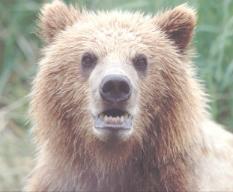This year’s population decline of females with cubs triggers concern among federal biologists. Despite de-listing of the grizzly bears less than a year ago, recovery of the grizzly bear population in Yellowstone National Park is still being watched carefully. For 2007, officials have totaled up to 25 deaths of females over the age of 2 from hunting accidents, management removals and natural causes. For every bear reported, a possible two more went unreported, according to Chuck Schwartz, Interagency Grizzly Bear Study Team leader. Overall, the population of 571 bears in Yellowstone is thriving, but a seemingly small loss of young female bears can have a large impact on the population. A loss of 9% of the female population over two years would trigger a review and potential listing of the bears back under the protection of the Endangered Species Act.
Several environmental factors also contributed to the higher mortality this year. Three out of four of the bear’s critical foods were in short supply. Late frosts damaged the berry crops, Deaths of whitebark pine trees due to mountain pine beetles and blister rust meant a lack of pine seeds. There is actually a positive relationship between whitebark pine seed production and grizzly bear birth rates. Cutthroat trout struggle to hold their own against introduced lake trout. Cutthroat populations have declined in some streams from 60,000 in the 1970’s to only 500 this year. Additionally, the mild winter last year meant fewer elk winter-kill carcasses. Only the army cut-worm moth resource seems to be intact this year.
Most bears will look for alternative foods in years like this one. Researchers have been testing the body fat content of the bears since 2000. They are finding bears entering dens at a 30% body fat, which indicates healthy animals, and a healthy environment. Still the lack of natural food sources is cause for worry. One year of high female mortality is not a crisis, but officials will be monitoring the population numbers in the coming year. “Our major concern through all of this is that we don’t allow the bear population to decline because of humans” says Schwartz.
Excerpted from an article by Cole Hatch, Jackson Hole News and Guide, October 31, 2007,
Submitted by Julie Hopkins
skip to main |
skip to sidebar

"News about bears, and activities of the GBOP team as they promote an accurate understanding of grizzly bears and their recovery in the North Cascades Ecosystem through community education and involvement."
About Us

- The GBOP team
- The Grizzly Bear Outreach Project (GBOP) provides education and community outreach about Grizzly Bears in the North Cascade Ecosystem (NCE) of Washington State. This includes information about grizzly bear ecology and behavior, sanitation and safety in bear country, and policies associated with the recovery process. The project engages community members in a process of education and rational, multi-party dialogue that targets people living, recreating, and working in the NCE. It provides a non-advocacy setting for residents to make well-informed opinions on grizzly bear recovery, perceptions and attitudes towards bears based upon accurate information. Over the last two hundred years, the number of grizzly bears (Ursus arctos) has declined from an estimated 100,000 individuals in the lower 48 to around 1100. The grizzly bear was listed as a threatened species by the U.S. Fish and Wildlife Service in 1975 and six recovery ecosystems have been established since that time. The North Cascades Ecosystem (NCE) in North Central Washington is the largest grizzly bear recovery ecosystem. Less than 20 grizzly bears currently live in the NCE. photo credit: Chris Weston